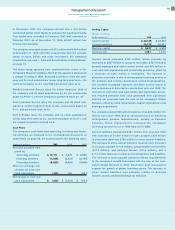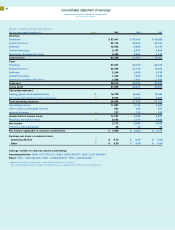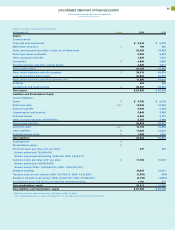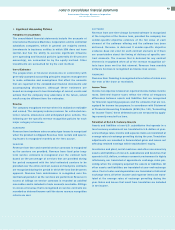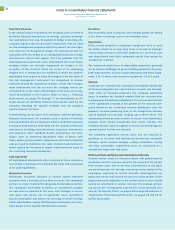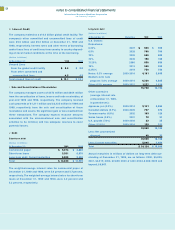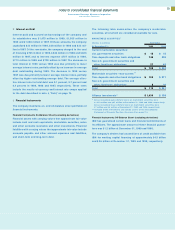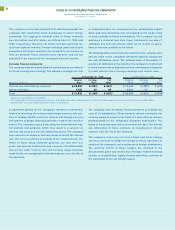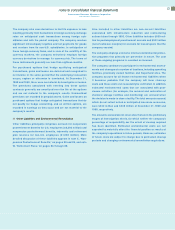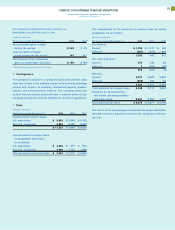IBM 1999 Annual Report Download - page 71
Download and view the complete annual report
Please find page 71 of the 1999 IBM annual report below. You can navigate through the pages in the report by either clicking on the pages listed below, or by using the keyword search tool below to find specific information within the annual report.
notes to consolidated financial statements
International Business Machines Corporation
and Subsidiary Companies
ASignificant Accounting Policies
Principles of Consolidation
The consolidated financial statements include the accounts of
International Business Machines Corporation and its controlled
subsidiary companies, which in general are majority owned.
Investments in business entities in which IBM does not have
control, but has the ability to exercise significant influence
over operating and financial policies (generally 20-50 percent
ownership), are accounted for by the equity method. Other
investments are accounted for by the cost method.
Use of Estimates
The preparation of financial statements in conformity with
generally accepted accounting principles requires management
to make estimates and assumptions that affect the amounts
that are reported in the consolidated financial statements and
accompanying disclosures. Although these estimates are
based on management’s best knowledge of current events and
actions that the company may undertake in the future, actual
results may be different from the estimates.
Revenue
The company recognizes revenue when it is realized or realizable
and earned. The company reduces revenue for estimated cus-
tomer returns, allowances and anticipated price actions. The
following are the specific revenue recognition policies for each
major category of revenue.
HARDWARE
Revenue from hardware sales or sales-type leases is recognized
when the product is shipped. Revenue from rentals and operat-
ing leases is recognized monthly as the fees accrue.
SERVICES
Revenue from time and material service contracts is recognized
as the services are provided. Revenue from fixed price long-
term service contracts is recognized over the contract term
based on the percentage of services that are provided during
the period compared with the total estimated services to be
provided over the entire contract. Losses on fixed price contracts
are recognized during the period in which the loss first becomes
apparent. Revenue from maintenance is recognized over the
contractual period or as the services are performed. Revenue in
excess of billings on service contracts is recorded as unbilled
receivables and is included in trade accounts receivable. Billings
in excess of revenue that is recognized on service contracts are
recorded as deferred income until the above revenue recognition
criteria are met.
SOFTWARE
Revenue from one-time charge licensed software is recognized
at the inception of the license term, provided the company has
vendor-specific objective evidence of the fair value of each
element of the software offering and the software has been
delivered. Revenue is deferred if vendor-specific objective
evidence does not exist for each contract element, or if there
are uncertainties about the timing of delivery of specific con-
tract elements. The revenue that is deferred for any contract
element is recognized when all of the revenue recognition cri-
teria have been met for that element. Revenue from monthly
software licenses is recognized as license fees accrue.
FINANCING
Revenue from financing is recognized at level rates of return over
the term of the lease or receivable.
Income Taxes
Income tax expense is based on reported income before income
taxes. Deferred income taxes reflect the effect of temporary
differences between assets and liabilities that are recognized
for financial reporting purposes and the amounts that are rec-
ognized for income tax purposes. In accordance with Statement
of Financial Accounting Standards (SFAS) No. 109, “Accounting
for Income Taxes,” these deferred taxes are measured by apply-
ing currently enacted tax laws.
Translation of Non-U.S. Currency Amounts
Assets and liabilities of non-U.S. subsidiaries that operate in a
local currency environment are translated to U.S. dollars at year-
end exchange rates. Income and expense items are translated at
average rates of exchange prevailing during the year. Translation
adjustments are recorded in Accumulated gains and losses not
affecting retained earnings within stockholders’ equity.
Inventories and plant, rental machines and other non-monetary
assets and liabilities of non-U.S. subsidiaries and branches that
operate in U.S. dollars, or whose economic environment is highly
inflationary, are translated at approximate exchange rates pre-
vailing when the company acquired the assets or liabilities. All
other assets and liabilities are translated at year-end exchange
rates. Cost of sales and depreciation are translated at historical
exchange rates. All other income and expense items are trans-
lated at the average rates of exchange prevailing during the
year. Gains and losses that result from translation are included
in net income.
69


